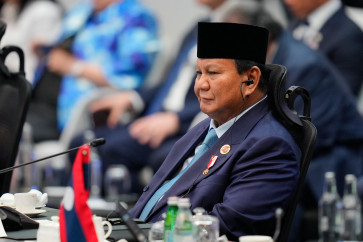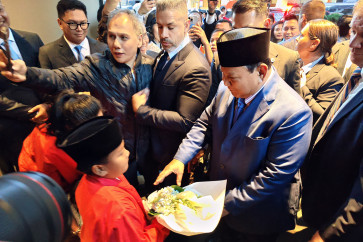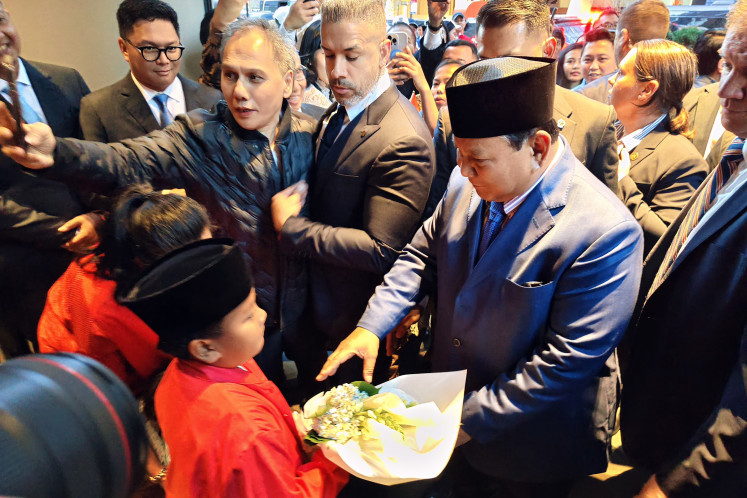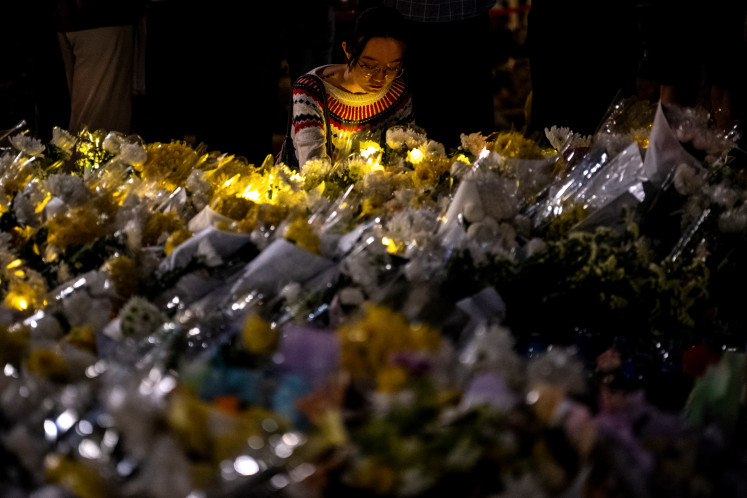Popular Reads
Top Results
Can't find what you're looking for?
View all search resultsPopular Reads
Top Results
Can't find what you're looking for?
View all search resultsDancing to a timeless beat
The small field beside the mosque in Kecicang village, Karangasem, was packed with people one sunny afternoon
Change text size
Gift Premium Articles
to Anyone
T
he small field beside the mosque in Kecicang village, Karangasem, was packed with people one sunny afternoon. Groups of children hunted for the best spots amid the crowds of adults lining all four sides of the field.
They were all waiting for the Rudat troupe to make its entrance. With its popular traditional performances, Rudat always brings an air of joyous festivity.
Mahdan, one of the residents of Kecicang, had invited and paid the troupe to bring that air of joyous festivity to his wedding reception.
"I was once a member of a Rudat troupe," he said, a wide smile on his face. "The troupe that will perform here is the Kecicang's one," he added.
A series of high-pitched sounds forced Mahdan to shift his gaze to the open field. The sounds came out of the shiny aluminum whistle blown by the Ance (troupe leader) as he led his Rudat performers onto the field. The spectators shouted and applauded to welcome the troupe.
A remnant of the past: Having existed in Karangasem since the region’s feudal era, Rudat troupes can now only be found in the regency’s Muslim villages. (JP/I Wayan Sunarta)
The Ance proudly marched in front of the troupe. He sounded the whistle to control the pace of the other performers - although the Ance himself didn't have to obey the orders. He was the leader, after all. He was free to improvise, a special privilege he enjoyed to the full, solely to impress the beautiful village girls. With a locally made Katana sword in his right hand and a glittering whistle in his left, the Ance had all the gear he needed to make some funny moves.
The girls, some wearing a head covering, acknowledged his efforts by rewarding him with sweet smiles. The children giggled at this wordless repartee. Members of the Rudat troupe wore a distinctive costume. The four men who formed the front line of the troupe were dressed all in black: long-sleeved shirts, trousers and police-style caps. Each also sported dark sunglasses. A colorful shoulder badge and bandoleer decorated their shirts.
The 12 men who formed the rear line, by contrast, were dressed all in white. Instead of a police-style cap, each wore a kopiah (a fez without a tassel) as his headgear of choice. They also wore shiny red paper bandoleers.
"Generally, a Rudat troupe consists of 21 performers, but it is not a fixed number," Mahdan explained.
Following the funny opening antics by the Ance, the troupe launched into some more serious business. They displayed various marching formations before demonstrating their skills in the traditional martial art of silat. They threw punches and performed a combination of low and high kicks, defensive parries and an offensive grab-and-throw. They moved as if engaged in deadly hand-to-hand combat against invisible enemies.
The members of the troupe performed these difficult maneuvers while singing a series of spirited songs in Malay and Arabic. The sounds of the rebana (a handheld single-headed drum), jidur (large rebana) and trenteng (two-headed drum) played by a group of elderly musicians served as the musical accompaniment to the Rudat performance.
As the drumbeat picked up tempo, the Rudat performers awed the crowd with lightning-fast silat choreography.
Rudat performances generally comprise three different parts. In the opening, performers greet the audience; in the second part, they sing their praises to the Prophet Muhammad. In the third part, the performers apologize to the audience for any mistakes they made during the performance.
Rudat has existed in Karangasem since the region's feudal era. Nowadays, Rudat troupes are found in the regency's Muslim villages, such as in Kecicang, Ujung, Saren Jawa, Tohpati and Bukit Abuan.
Rudat also exists in other Muslim villages across Bali, such as Kampung Jawa and Pemogan in Denpasar and Pegayaman in Buleleng.
According to Mudahar, a 60-year-old resident of the village, the first Rudat troupe in Karangasem was established in Tohpati village. The founder, he said, was a Javanese cleric, Raden Kyai Jalil, who died in Tohpati and was buried in the village's cemetery. Mudahar could not state exactly when in history this took place, saying only that it occurred "a very long time ago".
"Raden Kyai Jalil also introduced Rudat to Saren Jawa village," he added. "And the Rudat troupe in Kecicang was founded by an Arab man, Ami Ali Muhammad."
Rudat is performed mainly during the celebration of major Muslim religious festivals, such as weddings, circumcisions, Maulud Nabi (the birthday of the Prophet Muhammad) and Idul Fitri.
"Here, the Rudat troupe also performs during major functions at Karangasem palace," Mudahar said.
That fact underlines the close relationship between the Hindu aristocrats of Karangasem and their Muslim subjects.
Details on the origins of Rudat are still sketchy. Some say that Rudat developed from zikir zaman, which is the choral singing of Arabic texts in praise of the Prophet Muhammad accompanied by silat movements, and burdah, the singing of Arabic texts accompanied by the rebana.
Other sources claim Rudat originated in Turkey and was brought to Indonesia in the 15th century during the advent of Islam in Java.










